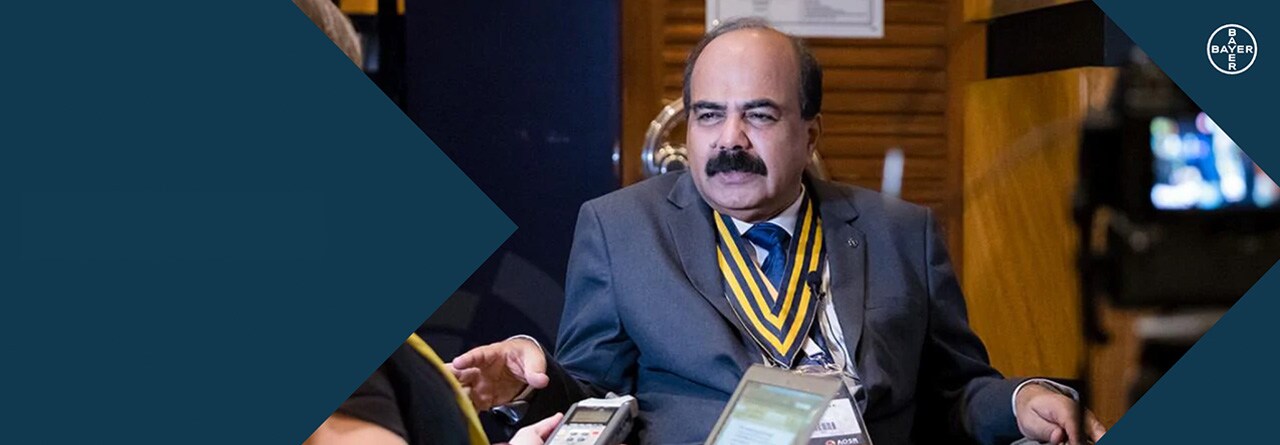“India is not the Country of Snakes and Elephants”
Radiology in India is facing turf battles, says Dr. K. Mohanan, so IRIA members should remain unified and tackle medical and political challenges together. Mohanan is the new president of the Indian Radiological and Imaging Association (IRIA).
radiology.bayer.com (rbc): Dr. Mohanan, congratulations on your presidency. As a long-time member, which IRIA achievements are you most proud of?
K. Mohanan (KM): IRIA is the only association of radiologists in India. It unifies each and every radiologist in our country and that is its importance.
Radiology is slightly different from other specialities, it is highly technology-driven. Safety hazards are also an important issue. This requires interaction with the government and other regulatory agencies. A single individual cannot handle all this; it needs a strong association and motivated leaders. I think IRIA is doing a good job regarding both the medical and political issues.
rbc: What will you focus on during your presidency?
KM: My main focus will be taking care of our members’ needs. The profession comes first. If our members face a professional problem, IRIA will take care of it by legal means and official interaction with the government.
Radiology is currently in a turf war with other specialties. Right now, radiologists are doing ultrasound, CT and MRI imaging, but other specialists are intruding. Therefore, we have a mission: The radiologists should always be the most qualified person and should be able to have the final word in imaging. This requires continuous updating of our knowledge and continuing medical education programs. Only the association can offer this, the government cannot.
On Education
rbc: Education comes first?
KM: Yes, and that is actually what AOCR 2018 was made for. Ninety percent of this four-day conference was about teaching and learning. We offered five to six sessions at the same time concentrating on education, interaction and learning. Only about ten percent of the time was spent on organizational activities.

rbc: Which particular education topic is in your focus?
KM: One area will definitely be fetal imaging. We have a turf issue there: Should a gynecologist and obstetrician do fetal imaging or should it be a radiologist?
A patient usually goes to the gynecologist first and gets the first antenatal scan done. However, fetal imaging is not ultrasound alone. It includes various other modalities of imaging and radiologists are the experts for any kind of imaging. Gynecologists and others can do the initial scan, but every second opinion should come from a radiologist. So we will empower our young radiologists for this.
On Female Fetocide
rbc: You have said previously that the harassment or radiologists on account of the Pre-Conception and Pre-Natal Diagnostic Techniques (PCPNDP) Act needs to stop – what do you mean by that?
KM: Everybody knows that the female population in India is less than the male population compared to many other countries. The government thought the solution for this problem was legislation, so the parliament passed the PCPNDT Act in the Nineties without the extensive discussion it needed. So far, the PCPNDT Act has not met the expectation of increasing the birth of female babies.
Now, if somebody determines sex before birth and then subjects the female fetus to feticide, that person will get punished – and it should rightfully be so. But if a person does a scan honestly without identifying the sex of the fetus and gives a report, but subsequently in the records sent to the health authority regarding the number of cases scanned some error creeps in, he will be punished. The punishment for this minor error and the grave mistake of revealing the sex of the fetus are the same. This is a weakness of the law, which should be corrected.
In addition, such legal provisions give a lot of power to the inspecting authorities to harass the doctor doing the scan. This also needs to be corrected. Regarding the PCPNDT Act, I am meeting with Indian government officials by the end of January. We also have a case on this issue coming up in the supreme court of India by the end of February.

rbc: Why is the PCPNDT Act failing?
KM: Female feticide is a social problem, not a medical, nor a legal problem. It is a matter of attitude. If you look at my home state Kerala, in South India, there is great respect for women. As census records show, we always had a higher number of women than men, even before the PCPNDT rule. Being the first IRIA president from Kerala, I should try to correct the skewed sex ratio in India.
That is why we have launched a new program this year called “Raksha” – calling on all radiologists to save the girl child. This program supports social awareness programs, girls’ education, and girls’ schools. We need this kind of social change. I hope the entire country will take it up.
On Politics
rbc: Which other political activities will you engage in?
KM: We are currently working on regulating the purchase of high-end radiology equipment. If high-end technology is purchased, a qualified radiologist must handle it.
Some radiology equipment has high radiation risk. We know from various studies and personal experience that radiologists and radiographers know about radiation safety and take precautions when using such machines. On the other hand, cardiologists, orthopedics and neurologists get a lot of radiation, because radiation protection is not included in their curriculum. Permitting these specialists to buy and operate machines without any regulation is dangerous not only for them but also for everyone else.
We discussed this problem with the Atomic Energy Regulatory Board representatives. The chairman himself came to our conference and spent a lot of time discussing modifications in the regulations regarding radiation equipment. This is an example of how we take care of the profession.
rbc: You mentioned taxes on imaging machines in your inauguration speech. Where do you stand on that?
KM: No-one should be taxing life-saving devices. A CT scanner is not for enjoyment nor is it a luxury item. Why would anybody impose a twenty to thirty percent tax on it?
The same applies to life saving drugs or other life saving devices – they should all be exempt from tax. Taxing such things is a crime, to say the least.
rbc: Does that message reach the politicians?
KM: One good thing about politicians in India is that they are easily accessible. We do have access. Most of them understand our requirements, and if possible, they try to implement our suggestions. They know that healthcare affects the general population and if they do a politically positive thing, they will get voters, which in turn is good for them also.
rbc: There is also a lot of talk at AOCR2018 about the shortage of radiologists. How will you tackle that?
KM: There is definitely a shortage of radiologists in India. In addition, we face a distribution problem. Mumbai has probably more radiologists than many other cities in the world. But if you travel a little outside of Mumbai, you may not find a single radiologist. That is an issue for the medical profession as a whole, not for radiologists alone.
The Medical Council of India has decided to increase the postgraduate medical seats to a level equal to the undergraduate seats. So there is sustained effort – seats will be increased.
More than 50 percent of our radiologists are below forty years and they have great potential. But hospitals need to be set up in the periphery, as there is no point in sending a radiologist to a rural area without a hospital, without ultrasound and X-ray machines. Both should develop simultaneously.
On Expectations
rbc: What do you expect from your members?
KM: They should remain unified, and not engage in internal conflicts. Whenever a colleague has a problem, they should join and help and support him. Whenever they have a problem, they should contact the association. And whenever the association asks them for a specific thing, they should believe the association and do it.

rbc: What do you expect from the industry?
KM: Whether it is an association or an individual radiologist, we need the best technology at the cheapest price. That is the bottom line. At the same time, a company should make profit to be able to continue R&D.
Investments can be created from profit only and we understand that. We are trying to help the industry by reducing the taxes. There is a huge market in India. I think, companies should think about producing things in India rather than importing them, which is costly.
They will find a very good environment in India now – with the government of India having launched “Make in India”. Since the market is so huge, volume will help them to reduce the cost. So all these things are possible. The best equipment at low cost will definitely be taken.
rbc: Is there something we have no talked about people should know about radiology in India?
KM: The image about India spread in the media – not recently, maybe in the past – is one of a country full of Kings snakes, and elephants. But it is not!
India is a technology hub; it has one of the largest pools of qualified scientists and doctors in the world. And, coming back to my specialty, Indian radiologists are the best in the world. If you go to any hospital anywhere, you will see an Indian radiologist. If you look at any of the textbooks, you will see Indian authors. If you read medical journals, many articles are from radiologists form India. India has great strengths in radiological imaging and medicine in general. The hospitals are good, the doctors are good, and the expense may be one tenth of what one needs to pay in the Western world.
rbc: People may also have the gap between urban and rural India in mind…
KM: The urban-rural gap is definitely there. Urban and rural India are practically two different countries. However, that gap is getting rapidly reduced and the next ten to fifteen years will bring a lot of change.
About K. Mohanan
IRIA President Dr. Kunnummal Mohanan is the head of the Radiodiagnosis Department at Govt. Medical College in Thrissur, Kerala, in the very South of India. He also serves as Dean at the Faculty of Modern Medicine, at Kerala University of Health Sciences. He is a board member of various institutions in his home state of Kerala and on a national level.
Video Recording
The entire interview (Duration: 22 minutes).



